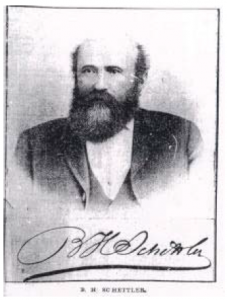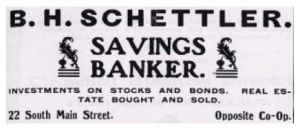Jacob Wayne Olmstead and Dr. Ignacio Garcia, Department of History
Bernhard Herman Schettler strolled down the dusty streets of Salt Lake City for the first time in the autumn of 1861, after making the three and a half month journey from New York City. Having made favorable impressions on George Q. Cannon, Orson Pratt, and others as a young stalwart leader among the German and Swiss members of the Church of Jesus Christ of Latter-day Saints in New York, he was brimming with the possibilities of making a difference in Zion. Schettler was destined to make an impact; however, it was not the impact he had suspected in 1861.
Nearly forty-five years later the anti-Mormon organ Goodwin’s Weekly described, in January 1905, a growing public perception of Schettler, who by then was a prominent fixture in both the business and Mormon communities of Salt Lake. “B. H. Schettler,” they editorialized “the bankrupt banker, . . . seems to have been born with the instincts of a swindler, . . . with a soul so sordid and frozen to human emotion that he is able to view with a sneer the sufferings and disaster he has wrought.”1 The germ for these remarks was laid three months earlier in October 1904. Schettler’s bank, which he established in 1892, was declared insolvent leaving its depositors without recourse to recover their losses. In the months that followed, as the bank’s books and ledgers were scrutinized, its depositors and the media became increasingly anxious to assign blame. Ironically, the anti-Mormon rhetoric in Goodwin’s, which sought to capitalize on the possibility of a prominent Mormon entangled in scandal, captured the feelings of both Mormons and non-Mormons who were in a quandary, for three months, trying to deduce Schettler’s involvement. A settlement to the debacle finally came in April 1905, the blame landing squarely upon Schettler, permanently ending his prestige and credibility as a business man.
While works of biography typically detail the significant contributions, or unparalleled experiences of an individual’s life, this essay is intended to reflect a common experience rather than a distinctive one. Schettler represents a class of second tier Salt Lake City business men, who did not penetrate the hierarchical realms of business, politics, or Mormonism, yet, were well known in their community. The collapse of Schettler’s bank and his life story has been largely forgotten in the annals of Utah and Mormon history.2 However, they illustrate important transitions which were taking place on national and state levels at the end of the nineteenth and early twentieth centuries. As America moved into the twentieth century its communities, which had informally and autonomously carried out their civic and economic business, were overtaken by the regulations and hierarchical necessities of Urban-industrial life.3 Moreover, the Schettler fiasco also illustrates Utah’s struggle exchanging the old Mormon world-view, which dominated its youthful territorialship, with the laws accompanying statehood. The struggles of both Mormons and non-Mormons, grappling with these changes are demonstrated in the paradoxical episode which enabled Schettler to be dubbed a saint by some and buccaneer by others.
For presentation and publication this story was told by weaving Schettler’s biography with the story surrounding the failure of his bank, to create an appreciation for his rise in both Salt Lake’s business and Mormon communities and the tragedy of his fall from grace with both. The story uncovered by my research into Schettler’s life and the collapse of his bank was presented at the Mormon History Association conference in May 2002 and submitted for publication with Utah Historical Quarterly in September 2002.
_______________________________________
Latter-day Saint Biographical Encyclopedia: A Compilation of Biographical Sketches Prominent Men and Women in the Church of Jesus Christ of Latter-day Saints, 4 vols. (Salt Lake City: Andrew Jenson History, 1901-1936), 4:356-357. The major studies dealing with early Utah banking interestingly fail to mention Schettler’s bank in their comprehensive lists of banks in Utah and Salt Lake City. See: John D. Speirs, “The History of Money and Banking in Utah,” (M. S. Thesis, University of Utah, 1935), 107a-b; Dale R. Hawkins, “Banking in Utah,” (M. S. Thesis, University of Utah, 1951), 247-248; Howard E. Parkinson, “The History of Banking in Utah, 1847-1896,” (M. S. Thesis, University of Utah, 1963), 56. However, Schettler’s bank is listed in a comprehensive list of Utah’s banks in Roland Stucki, Commercial Banking in Utah, 1847-1966 (Salt Lake City: Bureau of Economic and Business Research, College of Business, University of Utah, 1967), 27, and 144.
1. “Swindler Schettler,” Goodwin’s Weekly, Salt Lake City (7 January 1905), 4.
2. Several short biographical sketches have been published on Schettler’s life. Orson F. Whitney, History of Utah 4 vols. (Salt Lake City: George Q. Cannon and Sons, 1904), 4:308-310; Andrew Jenson,
3. Robert H. Wiebe, The Search for Order, 1877-1920 (New York: Hill and Wang, 1967), xiiixiv.


